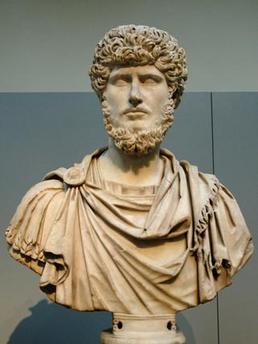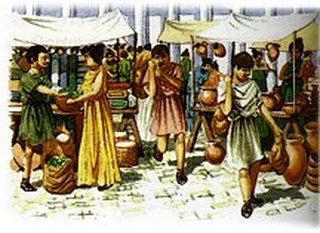GoRome
Government & Social Class
There are many reasons why you should visit Rome with the GoRome Travel Agency. One of those reasons is to see some of the great emperors that once rule this ancient empire. Also, you can go to one of the Patricians' amazing dinner parties. You might want to go and visit the Equestrians or perhaps the Plebeians. These are some of the things you can do the moment you step out of the Bubble of Time. Now let's explore these interesting topics you can see because of the amazingly hardworking staff at GoRome.

Julius Caesar
One of the many things you can go see with GoRome travel agency is the reign of Julius Caesar. You will be traveling back to about 46 B.C.E- 44 B.C.E. The amazing thing about Julius Caesar is that he started a civil war and quickly conquered a vast amount of area, which soon led him to become an emperor, one of the best ever. Another interesting thing that will make you want to go visit the time when Julius Caesar ruled, was that he adopted his nephew, Augustus, to become the next heir. Remember, seeing Julius Caesar has never been easier than with GoRome.

Augustus Caesar
One of the things GoRome highly recommends is going back to 31 B.C.E-44 B.C.E, which is the time of Augustus Caesar's reign. The reason why GoRome suggests to see Augustus is because he is able to handle things well, especially since he was put into politics at the age of 19. Also, if you enjoyed seeing his uncle, Julius, then you should definitely go visit Augustus because they are very similar, for example they both were some of the best emperors of all time. Traveling to see Augustus is very enjoyable with Rome.
Something that GoRome travelers commonly enjoy seeing is the Plebeians. The reason why we think people enjoy going to see this class is because it is the class with the common people and it is the largest social class after the slaves. The Plebeians consisted of farmers, bakers, builders, and craftsmen, some of these people were freemen. Some things our GoRome customers enjoy doing is joining them to get free entertainment and grains, which is something the Plebeians are lucky enough to get for free. Some of the people who visit ancient Rome like to listen to some of the freemen's, that are now Plebeians, stories of what it was like to be a slave. This is why our GoRome customers commonly like to visit the Plebeians.

Statue of an Equestrian
Something else our clients have fun doing is seeing the Equestrians. The Equestrians were originally the cavalry, but changed into tax collectors, bankers, miners, and exporters. This class was like the upper part of the middle class. Our clients say they like this class because they can kind of relate to them since most of our clients would be considered to be in the middle class. This is why the GoRome clients like the Equestrian class.

Patrician
The other class our GoRome customers like to see is the Patricians. The Patricians were the highest class besides the emperor and his family. The men in the Equestrian class got an extensive education and usually ended up having careers in politics and government. The reason why the GoRome customers like the Patrician class is because they like to see what it was like to belong in the upper class. That is what the Patricians would be like if you visited ancient Rome with GoRome.
Contact Info
Peyton Baur
Ancient Roman Government & Social Class expert from GoRome
Stanford graduate
1-800-888-GASC
[email protected]
Ancient Roman Government & Social Class expert from GoRome
Stanford graduate
1-800-888-GASC
[email protected]
Bibliography-Images
1. Julius Caesar. [Online image] Available at http://www.wpclipart.com/famous/political/Roman/Julius_Caesar_bust.png.html (May 20, 2011).
2. Augustus Caesar. [Online image] Available at http://www.bibleandscience.com/store/catalog/product_info.php?products_id=550 (May 20,2011).
3. Plebeians at a marketplace. [Online image] Available at http://www.sbceo.k12.ca.us/~vms/carlton/Rome/Rome_Reading_1.html (May 20, 2011).
4. Statue of an Equestrian. [Online image] Available at http://www.igougo.com/journal-j33108-Rome-La_dolce_vita_a_Roma.html (May 20, 2011).
5. Patrician. [Online image] Available at http://www.qwiki.com/q/#!/Roman_portraiture (May 20,2011).
2. Augustus Caesar. [Online image] Available at http://www.bibleandscience.com/store/catalog/product_info.php?products_id=550 (May 20,2011).
3. Plebeians at a marketplace. [Online image] Available at http://www.sbceo.k12.ca.us/~vms/carlton/Rome/Rome_Reading_1.html (May 20, 2011).
4. Statue of an Equestrian. [Online image] Available at http://www.igougo.com/journal-j33108-Rome-La_dolce_vita_a_Roma.html (May 20, 2011).
5. Patrician. [Online image] Available at http://www.qwiki.com/q/#!/Roman_portraiture (May 20,2011).
Bibliography-Sources
1. “Roles of Men, Women, and Children in Ancient Rome.” http://chalk.richmond.edu/education/projects/webunits/greecerome/Romeroles1.html (May 8, 2011).
2. “Roman Women: Following the Clues.” http://www.bbc.co.uk/history/ancient/romans/roman_women_01.shtml (May 6, 2011).
3. “Government in Rome.” http://chalk.richmond.edu/education/projects/webunits/greecerome/Romegovt1.html (May 8, 2011).
4. “Social Order.” http://www.pbs.org/empires/romans/empire/order.html (May 5, 2011).
5. “Social Pecking Order in the Roman World.” http://www.bbc.co.uk/history/ancient/romans/social_structure01.shtml (May 8, 2011).
6. "Emperors." http://www.pbs.org/empires/romans/empire/emperors.html (May 9,2011).
2. “Roman Women: Following the Clues.” http://www.bbc.co.uk/history/ancient/romans/roman_women_01.shtml (May 6, 2011).
3. “Government in Rome.” http://chalk.richmond.edu/education/projects/webunits/greecerome/Romegovt1.html (May 8, 2011).
4. “Social Order.” http://www.pbs.org/empires/romans/empire/order.html (May 5, 2011).
5. “Social Pecking Order in the Roman World.” http://www.bbc.co.uk/history/ancient/romans/social_structure01.shtml (May 8, 2011).
6. "Emperors." http://www.pbs.org/empires/romans/empire/emperors.html (May 9,2011).

